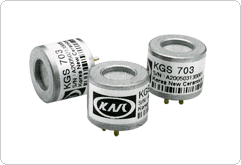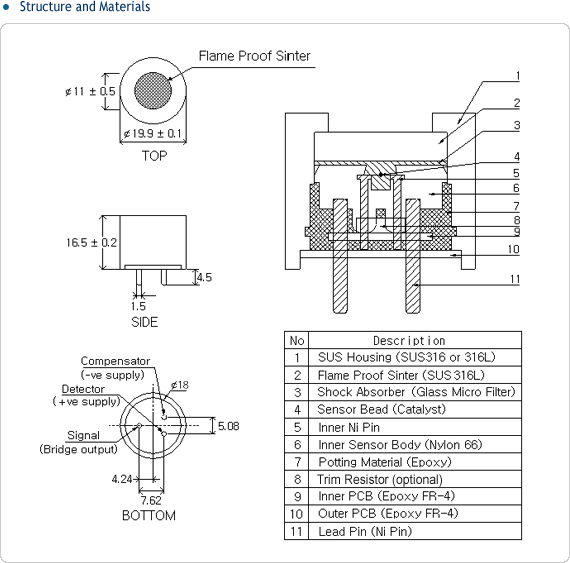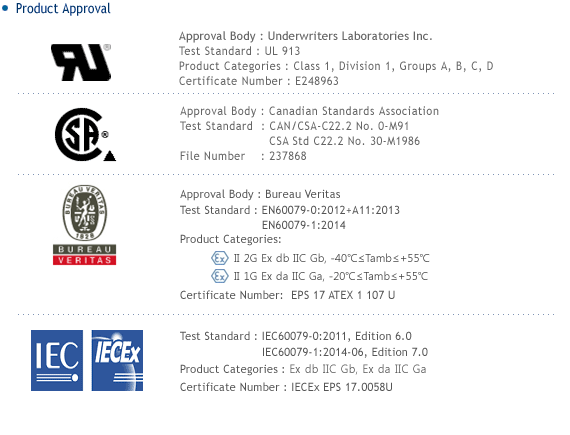|
|
|
 KGS 703 KGS 703
|
 |
|
|
 |
|

- Significantly increased HMDS (silicone) resistance
- Significantly increased H2S inhibition resistance
- Excellent shock resistance and reduced orientation effects
- Reduced response time and wake up times
|
|
 |
|
| Gases Detected |
Most combustible gases |
| Range |
0 ~100% LEL |
| Operating Voltage |
4.25 V |
| Current |
56 ± 6 mA |
| Output Sensitivity |
40 ± 6 mV / % methane |
| Zero Offset Voltage |
-20 ~ 20 mV (23 ± 2 ℃, 60% RH) |
| Linear to |
3% methane |
| T90 Response Time |
< 10 seconds (methane) |
| Long Term Sensitivity Drift |
< 5% signal / month |
| Long Term Zero Drift |
< 5% LEL (methane)/ month |
| Warranty Period |
1 year from date of despatch |
|
| * Flow rate of 300ml/min. Conditions at 23 ± 2 ℃, 60%RH, and 1 atm unless otherwise noted. |
|
 |
| Gas/Vapor |
% Relative Sensitivity |
| Methane |
100 |
| Hydrogen |
106 |
| Ethylene |
96 |
| Propane |
82 |
| Isobutane |
74 |
| n-Pentane |
67 |
| Hexanes |
50 |
|
| * The result are intended for guidance only at the same %LEL concentration |
|
 |
|
 |
|
|
Instructions specific to hazardous area installations
(reference European ATEX Directive 2014/34/EU)
Instructions for equipment covered by certificate number EPS 17 ATEX 1 107 U and IECEx EPS 17.0058 U
- With apparatus group IIA, IIB, and IIC, the equipment may be used with flammable gases and vapors.
- The equipment shall be used in ambient temperatures of -40℃ to +55℃ in Gb and -20℃ to +55℃ in Ga.
- The equipment is not considered as a safety related device (as referred to by Directive 2014/34/EU)
- Properly trained personnel shall install the equipment in accordance with the applicable code of practice (e.g. EN/IEC 60079-14)
- Properly trained personnel shall carry out inspection and maintenance in accordance with the applicable code of practice (e.g. EN/IEC 60079-17)
- Properly trained personnel shall carry out repair of this equipment in accordance with the applicable code of practice (e.g. EN/IEC 60079-19)
- Sensor pins are designed to be connected to a gas detector which shall provide an intrinsically safe supply and having a maximum output power. It should be stated that according to EN/IEC60079-1 clause 4.2 the input power must be limited by circuit complying with type of protection "ia" according to EN/IEC 60079-11.
- The confirmation of adequate sensor performance is recommended to be carried out regularly by a specified sensor calibration procedure.
The calibration shall be done as often as needed according to surrounding environment where the sensor is intended to operate.
- The following materials are used for the construction of this equipment.
- Housing Material: Stainless steel 316 or 316L
- Sinter Material: Stainless steel 316L
- Sinter Material: Maximum pore size of 70㎛
- Sinter Material: Density of 4.0 to 6.0g/㎤
- Cement Material: Epoxy resin
- Cement Material: Maximum functional temperature of 150 ℃
Where there is a risk of the equipment exposed to harmful substances (e.g. acidic liquids or gases that may damage metals, or solvents that may affect polymeric materials), the user is responsible for taking the suitable precautions (e.g. regular checks as part of routine inspections or establishing from the material’s data sheet that it is resistance to specific chemicals). The precautions are to prevent the equipment from being adversely affected and to ensure that the type of protection shall be maintained.
- The following factors are identified to have a harmful effect on catalytic elements as used in the gas sensors, KGS 701, KGS 702 and KGS 703.
Poisoning: some compounds will decompose on the catalyst and form a solid barrier over the catalyst surface. This action is cumulative and prolonged exposure will result in an irreversible decrease in sensitivity. The most common of these substances are: lead or sulphur containing compounds; silicones; phosphates.
Inhibition: certain other compounds, especially hydrogen sulphide and halogenated hydrocarbons, are absorbed or form compounds that are absorbed by the catalyst. The resultant loss of sensitivity is temporary and in most cases a sensor will recover after a period of operation in clean air.
If the presence of poisoning or inhibition is suspected, adequate protective action for the sensor should be taken.
- The Certification marking is shown below.
Ga, -20℃ ≤ Tamb ≤ +55℃ marking

Gb, -40℃ ≤ Tamb ≤ +55℃ marking

|
|
 |
|




